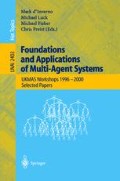Abstract
We propose an abstract mathematical model of space and time within which to study agents, multi-agent systems and their environments. The model is unusual in three ways: an attempt is made to reduce the structure and behaviour of agents and their environment to the properties of the “matter” of which they are composed, a “block time” perspective is taken rather than a “past/present/future” perspective, and the emphasis is placed on discovering agents within the model, rather than on designing agents into it. The model is developed in a little semi-formal detail, some relevant experimental computational results are reported, and questions prompted by the model are discussed.
Access this chapter
Tax calculation will be finalised at checkout
Purchases are for personal use only
Preview
Unable to display preview. Download preview PDF.
References
Angeline, P. J., Saunders, G. M., Pollack, J. B.: An Evolutionary Algorithm that Constructs Recurrent Neural Networks. IEEE Transactions on Neural Networks, Vol. 5, No. 1 (1994) 54–65
Beer, R.: On the Dynamics of Small Continuous-Time Neural Networks. Adaptive Behavior, Vol. 3, No. 4, (1995) 469–509
Doran, J.E.: Trajectories to Complexity in Artificial Societies: Rationality, Belief and Emotions. In: Dynamics in Human and Primate Societies. Kohler, T.A., Gumerman, G.J., eds., Santa Fe Institute Studies in the Sciences of Complexity, Oxford University Press, Oxford and New York, (2000) 89–106
Eliasmith, C.: The Third Contender: a Critical Examination of the Dynamicist Theory of Cognition. Philosophical Psychology. Vol. 9(4), (1996) 441–463
Gilbert, N.: Modeling Sociality: The View from Europe. In: Dynamics in Human and Primate Societies. Kohler, T.A., Gumerman, G.J., eds., Santa Fe Institute Studies in the Sciences of Complexity, Oxford University Press, Oxford and New York, (2000) 355–371
Kluver, J., Schmidt, J.: Topology, Metric and Dynamics of Social Systems. Journal of Artificial Societies and Social Simulation, Vol. 2(3), (1999) <http://www.soc.surrey.ac.uk/JASSS/2/3/7.html>
Naber, G. L.: Spacetime and Singularities: An Introduction. Cambridge University Press, Cambridge (1988)
Price, H.: Time’s Arrow & Archimedes’ Point. Oxford University Press, Oxford and New York (1996)
Russell, S., and Norvig, P. (eds.): Artificial Intelligence: a Modern Approach. Prentice Hall (1995)
Saunders, G. M., Pollack, J. B.: The Evolution of Communication Schemes over Continuous Channels. In: From Animals to Animats 4. Proceedings of the Fourth International Conference on Simulation of Adaptive Behaviour (eds. P. Maes, M. J. Mataric, J-A. Meyer, J. Pollack and S. W. Wilson). September 9th-13th, 1996, Cape Cod, Massachusetts, (1996) 580
Teuscher, C.: Study, Implementation and Evolution of the Artificial Neural Networks Proposed by Alan M. Turing: A Revival of his “Schoolboy” Ideas. Swiss Federal Institute of Technology, Lausanne, Logic Systems Laboratory, EPFL-DI-LSL, CH-1015, Lausanne (2000)
Turing, A. M.: Intelligent Machinery. Report Submitted to UK National Physical Laboratory, 1948. Reprinted in: Machine Intelligence 5. Meltzer, B., Michie, D., eds., Edinburgh University Press, Edinburgh (1969) 3–23
Turing, A. M.: Computing Machinery and Intelligence. MIND: a Quarterly Review of Psychology and Philosophy, Vol. LIX, No. 236, (1950) 433–460
Weiss, G. (ed.): Multiagent Systems. The MIT Press, Cambridge, Mass. and London, England (1999)
Werner, E.: Cooperating Agents: A Unified Theory of Communication and Social Structure. In: Distributed Artificial Intelligence, Volume II. Gasser, L., Huhns, M.N. eds., Pitman, London and Morgan Kaufmann, San Mateo, California (1989) 3–36
Wuensche, A.: Discrete Dynamical Networks and their Attractor Basins Complexity International, Volume 6, (online), and SFI Working Paper, 98-11-101 (1998)
Yamauchi, B.M., Beer, R. D.: Sequential Behavior and Learning in Evolved Dynamical Neural Networks. Adaptive Behavior, Vol. 2, No. 3 (1994) 219–246
Author information
Authors and Affiliations
Editor information
Editors and Affiliations
Rights and permissions
Copyright information
© 2002 Springer-Verlag Berlin Heidelberg
About this paper
Cite this paper
Doran, J. (2002). Agents and MAS in STaMs. In: d’Inverno, M., Luck, M., Fisher, M., Preist, C. (eds) Foundations and Applications of Multi-Agent Systems. Lecture Notes in Computer Science(), vol 2403. Springer, Berlin, Heidelberg. https://doi.org/10.1007/3-540-45634-1_9
Download citation
DOI: https://doi.org/10.1007/3-540-45634-1_9
Published:
Publisher Name: Springer, Berlin, Heidelberg
Print ISBN: 978-3-540-43962-2
Online ISBN: 978-3-540-45634-6
eBook Packages: Springer Book Archive

